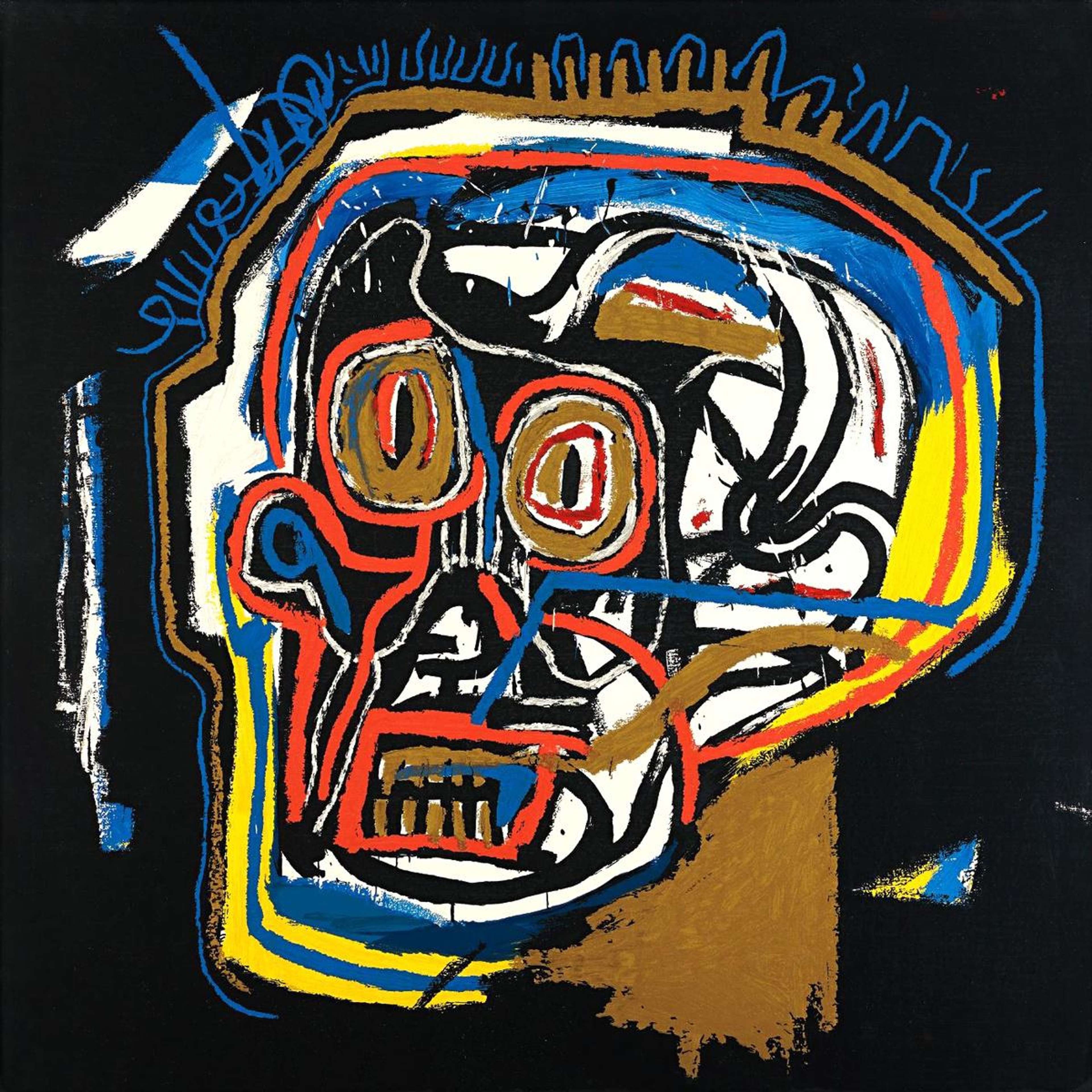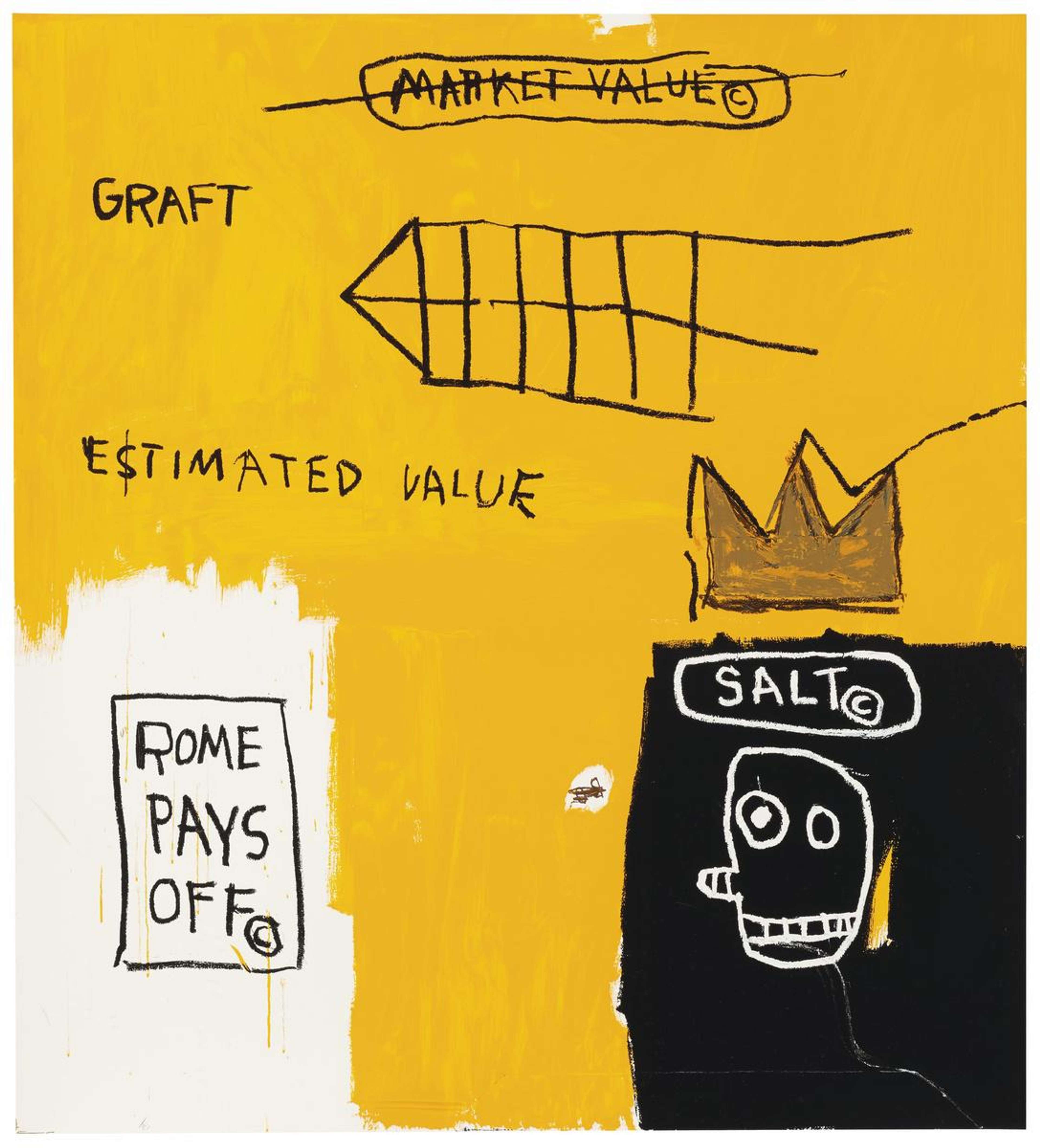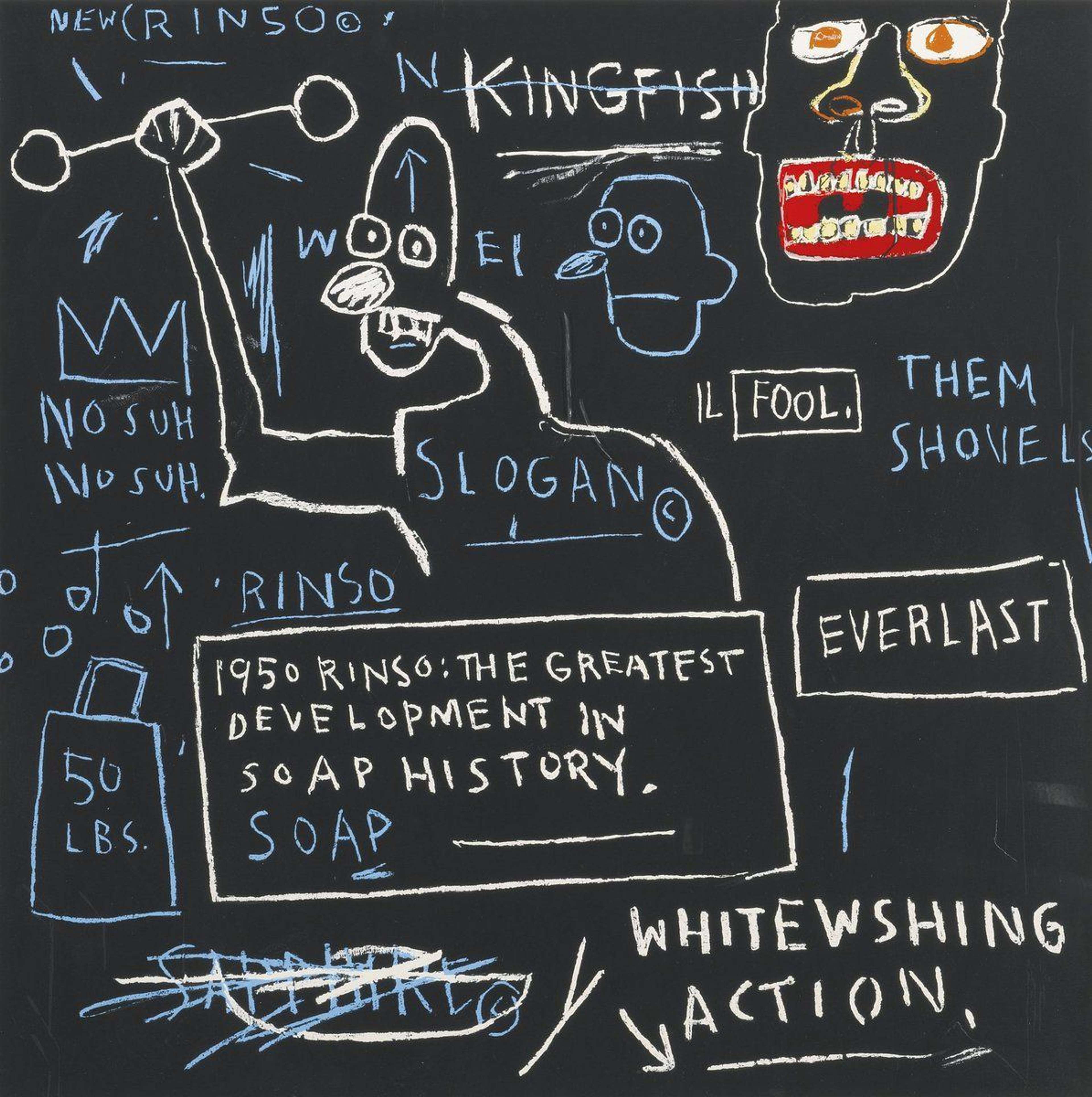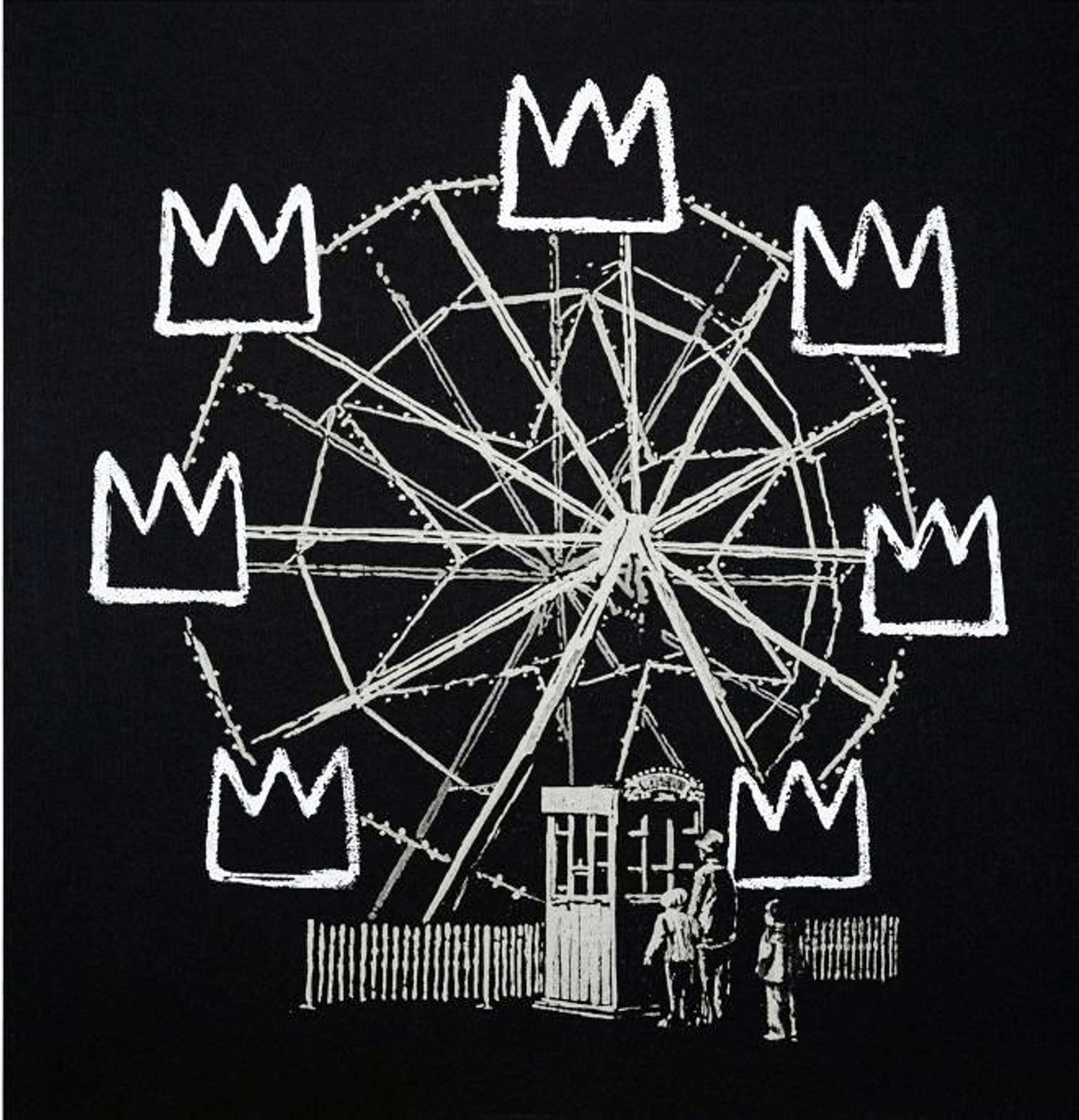From Graffiti to Gallery
 Olympic © Jean-Michel Basquiat 2017
Olympic © Jean-Michel Basquiat 2017
Interested in buying or selling
Jean-Michel Basquiat?

Jean-Michel Basquiat
57 works
Jean-Michel Basquiat, a pioneering artist who emerged as a prominent figure in the New York scene of the 1980s, left an indelible mark on the world of contemporary art. As a Black artist, Basquiat played a significant role in postmodern art movements, and his contributions continue to be celebrated today. Basquiat’s prodigious legacy - sculpted by his idiosyncratic style, symbolism, and technique - altered the course of Contemporary Art in his relatively short lifetime.
From Graffiti to Gallery: The Early Years
Born to a Haitian father and a Puerto Rican mother, Basquiat navigated the complexities of a mixed identity and struggled with physical health, having suffered a car accident in his childhood. His mother was a crucial figure in his life who inspired him to create and consume art, but also struggled severely with her mental health, requiring hospitalisation. This made him angry, confused and rebellious, and led him to run away from home at a young age – exposing him to the New York City underworld and its issues. Despite a rapid rise to fame, he still faced racism and discrimination, and the pressures of the art world alongside his own personal demons took a toll on his psychological well-being. His tragic death of a heroin overdose at the age of 27 was a reminder to many of the fragility of life, and the importance of supporting artists in their personal and professional lives.
Basquiat's artistic journey began in the late 1970s on the streets of New York City, where he worked as a graffiti artist under the pseudonym SAMO© alongside his friend Al Diaz. Their cryptic messages and unique drawings quickly captured the attention of the city's burgeoning art scene. In the early 1980s, Basquiat's graffiti made way for his work on canvas and paper, which began to be exhibited in galleries across New York City. As his art transitioned from street art to more traditional mediums, his aesthetic remained raw and unpolished, giving his work a distinctive edge that resonated with enthusiasts and collectors alike. Despite this, Basquiat's style also evolved, reflecting his unique identity and the diverse influences that shaped his work – including the mentorship of Andy Warhol and his friendship with Keith Haring.
His unique fusion of street art and fine art contributed to the growing recognition of street art as a legitimate and valuable form of artistic expression, further cementing his impact on the world of art.
 Image © Christie's / Arm and Hammer © Jean-Michel Basquiat and Andy Warhol 1984
Image © Christie's / Arm and Hammer © Jean-Michel Basquiat and Andy Warhol 1984Neo-Expressionism and Basquiat's Emergence
During the 1980s, Basquiat emerged as a leading figure in the Neo-Expressionist movement, a movement characterised by vivid colours, emotional intensity, and a return to figurative art – a reaction against the minimalism and conceptualism that had dominated the art scene throughout the 1970s. His art stood out for its raw energy, powerful imagery, and incisive social commentary, all of which resonated with audiences in a rapidly changing time period. He also attracted attention with his magnetic personality, had his own rock star persona and socialised with many other artists, including dating a certain up-and-coming singer named Madonna when they were both on the brink of fame.
As Basquiat's work gained traction in the art market, he became an influential figure in the New York art scene. His meteoric rise and patronage by influential characters such as Warhol and Larry Gagosian positioned him as a prominent representative of the contemporary art world, helping shape the trajectory of art history.
Technique and Style: The Artistic Evolution of Basquiat
Basquiat's style evolved over time, incorporating various techniques and materials in order to showcase his innovation and creativity. He often used mixed media and unusual surfaces such as doors for his work, combining elements of drawing, painting, and collage. His compositions were dense with symbols, text, and imagery, creating a complex visual language that demanded in-depth contemplation and interpretation.
Basquiat's style was heavily influenced by his heritage, drawing from African and Caribbean art, as well as his love for jazz, poetry, and popular American culture. His use of vibrant colours and dynamic lines imbued his work with a sense of energy, and the imperfections present convey a notion of urgency that set it apart from other artists of his time.
Themes and Symbolism in Basquiat's Work
The themes illustrated in Basquiat’s artistic style are closely interconnected with the struggles and triumphs he experienced during his life. Throughout his career, Basquiat's art tackled themes such as race, power, and social inequality. He largely used symbols to represent these ideas, drawing from a diverse range of sources including historical references, religious iconography, and popular culture. Recurring symbols include crowns, which have become synonymous with his work, and limbs – a fascination that began with her mother gifting him the book Gray’s Anatomy after his accident. His work often portrayed African American figures and celebrated Black culture, while simultaneously providing social commentary that highlighted the struggles faced by people of colour. His bold exploration of these issues raised awareness in a predominantly white art world, provoking deep reflection.
Basquiat's unique approach to themes and symbolism helped solidify his place in art history, as he challenged traditional norms and expectations in the fine art world. While it took a while for his artistic prowess to be acknowledged by traditional institutions (such as the MoMA, who famously rejected one of his works while he was still alive), they eventually caught up to his commercial success. Today, his work continues to inspire new generations of artists and scholars, who explore the depth and complexity of his artistic vision. Despite any personal struggles, Basquiat thrived in his artistic pursuits, ultimately becoming one of the most celebrated artists of our time.
Basquiat's Impact and Legacy
Basquiat's impact on contemporary art and pop culture is immeasurable. He broke barriers as an African American artist, carving out space for artists of colour in an overwhelmingly white-dominated art scene. His work has inspired countless artists and continues to be celebrated in museums and galleries worldwide. Echoing the commercial success he found in his life, he is now said to be the most collected artist by athletes, actors, musicians and entrepreneurs. His influence has also crossed over to pop culture, and he has been mentioned in songs by Kanye West and Jay-Z, to name a few.
Basquiat's contribution to the Neo-Expressionist movement and his influence on postmodern art remain a testament to his enduring legacy. In the years since his untimely death, Basquiat's work has gained even greater recognition and appreciation. Art collectors and enthusiasts alike have sought out his pieces, driving up their value and solidifying his position as a vital figure in 20th-century art. As a result, Basquiat's work has become a touchstone for discussions on race, identity, and the role of art in society. As the art world continues to grapple with questions of representation and inclusion, Basquiat's legacy serves as a powerful reminder of the need for diverse voices, and his life and work have become symbols of the potential for art to challenge established norms and to create new pathways for understanding and expression. There have been questions raised, however, about some of the ways in which Basquiat’s art has been commercialised, particularly by luxury brands. In 2021, an advert for Tiffany & Co. featuring Jay-Z and Beyoncé standing in front of Basquiat’s Equals Pi drew criticism, with his former studio assistant claiming “they wouldn’t have let Jean-Michel into a Tiffany’s if he wanted to use the bathroom or if he went to buy an engagement ring and pulled a wad of cash out of his pocket”.
Basquiat's influence can be seen across various art movements and genres. His innovative approach to blending different styles and techniques has paved the way for many contemporary artists who seek to challenge traditional artistic boundaries. In the realm of street art, Basquiat's early work as a graffiti artist continues to inspire new generations of artists. Banksy has often chosen to interact with Basquiat’s work, having created two murals at the Barbican in 2017. One of these also comments on the commodification of Basquiat’s work, and depicts people queuing in front of a ferris wheel with cars shaped like the artist’s iconic crowns.
Basquiat's work has also influenced the broader cultural landscape, with elements of his style and themes appearing in fashion, music, and film. As a result, Basquiat's legacy continues to shape the art market, influencing the value and perception of art from this period.
Celebrating the Life and Work of Jean-Michel Basquiat
The evolution of Basquiat's artistic style is a fascinating journey, reflecting his talent, passion, and the world that surrounded him. From his beginnings as a graffiti artist to his rise as a leading figure in the New York art scene, Basquiat's work remains an essential part of art history. His influence on contemporary art and his legacy as a Black artist continue to shape the world of art and inspire future generations.
When celebrating the life and work of Basquiat, we should be reminded of the power of art to give voice to the marginalised and challenge the status quo. Basquiat's evolution from street artist to celebrated painter serves as a testament to the transformative potential of creativity and artistic expression. In examining Basquiat's artistic style, we gain a deeper understanding of the complexities of his work and the many layers of meaning embedded within it.
As art collectors, enthusiasts, and scholars continue to engage with Basquiat's work, efforts to preserve his art for future generations have become increasingly important. Exhibitions, retrospectives, and scholarly research on Basquiat's work all have contributed to a deeper understanding of his artistic style and the context in which he created his art. The evolution of Basquiat's artistic style showcases the adaptability and timelessness of his work. Despite changing cultural landscape, his art continues to captivate audiences and spark conversations about race, power, and the role of art in society. His impact on contemporary art, the art market, and his enduring influence on future generations of artists demonstrate the lasting power of his vision.
Ultimately, the story of Basquiat's artistic evolution is one of triumph and tragedy, of a brilliant artist who left an indelible mark on the world of art. As we continue to celebrate the life and work of Jean-Michel Basquiat, we are reminded of the importance of nurturing diverse perspectives and fostering an inclusive environment for artists of all backgrounds. By preserving Basquiat's work, we can ensure that his legacy lives on and continues to inspire future generations of artists and art lovers.








